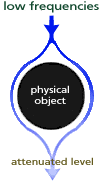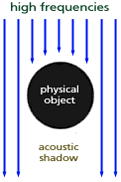| Diffraction |
| Like light, sound can bend around the boundaries of an object it encounters as it travels through the air. |
| This process is a function of frequency
with higher frequencies (having wavelengths
shorter than the size of the object) tending to be absorbed
by or reflected
off of the intervening object while lower frequencies (having wavelengths
greater than the object) will diffract and bend around the object to continue
their path at an attenuated intensity.
This leads to colouration of the perceived sound. This is an important issue in studio design and monitoring. |
 |
 |